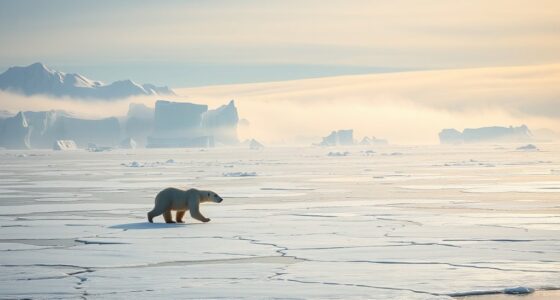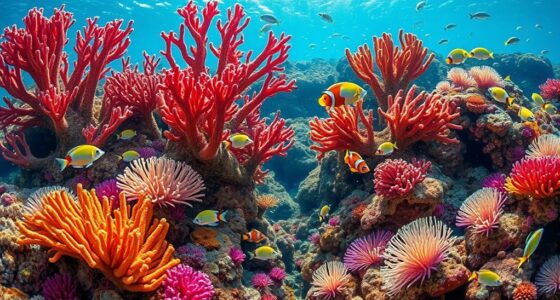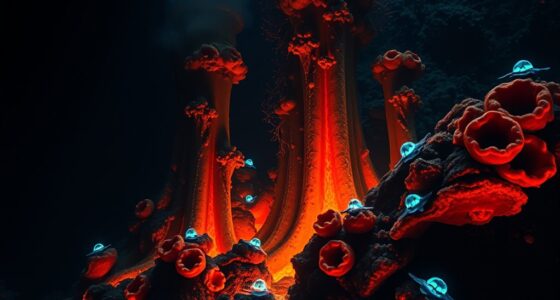When non-native species establish themselves in new environments, they can dramatically alter the balance of local ecosystems. Human activities like trade and travel often unintentionally help these invaders spread, sometimes with unforeseen consequences. Understanding how these creatures succeed and the damage they cause is crucial to managing their impact. The stories behind these invasions reveal a complex web of ecological and economic challenges that demand your attention.
The Pathways of Invasive Species Spread
Invasive species often spread through a variety of human-made and natural pathways, making their movement difficult to control. You might encounter them hitching rides on ships’ ballast water, hidden in soil or plants moved for landscaping, or attached to equipment transported across regions. They can also disperse naturally through wind, water currents, or animal movement, traveling long distances without human help. International trade and travel accelerate this process, unintentionally introducing species to new environments. Additionally, monitoring and regulation play crucial roles in preventing the spread of invasive species across borders. Once introduced, they find suitable conditions to establish themselves, often outcompeting native species. Understanding these pathways is crucial for preventing further spread, as many invasions occur quietly and rapidly, disrupting local ecosystems before anyone realizes what’s happening.
Characteristics That Make Certain Creatures Successful Invaders
Many species become successful invaders because they possess specific traits that give them an advantage in new environments. One key trait is high reproductive capacity; they produce many offspring quickly, increasing their chances of establishing a foothold.
These creatures often have broad diets, allowing them to thrive on various food sources and adapt to different conditions. They tend to be resilient, withstanding environmental stresses like pollution or climate shifts. Moreover, their ability to operate with leverage in financial markets enables rapid expansion and colonization efforts.
Additionally, successful invaders usually have rapid mobility, enabling them to disperse widely and colonize new areas swiftly. Many also lack natural predators in their introduced habitats, giving them an extra edge.
These traits, combined, allow invasive species to outcompete native organisms, disrupt local ecosystems, and establish dominance in their new territories.
Case Studies of Notable Ecosystem Disruptions
One of the most striking examples of ecosystem disruption caused by invasive species is the introduction of the zebra mussel in North American freshwater systems. Arriving in the Great Lakes via ballast water, these tiny mollusks quickly proliferated, attaching to native plants, rocks, and infrastructure. Invasive species have been known to cause significant ecological and economic impacts in various ecosystems worldwide. Their rapid spread clogged water intake pipes, damaged boats, and outcompeted native mussels for food and space. The ecological balance shifted as zebra mussels filtered vast amounts of plankton, reducing food availability for native species. This disruption altered food webs and decreased biodiversity. Their presence also facilitated the spread of other invasive organisms, further destabilizing ecosystems. This case highlights how a single invasive species can cascade through an ecosystem, causing profound and lasting changes.
Impact on Native Wildlife and Plant Life
The proliferation of invasive species like zebra mussels directly threatens native wildlife and plant life by disrupting established ecological relationships. You might notice native fish struggling to find food as invasive mussels filter out plankton they depend on. Natural habitats are often altered as invasive species modify the landscape, making it difficult for native species to survive. Plants also suffer; invasive plants often outcompete native species for sunlight, water, and nutrients, leading to reduced biodiversity. Birds that rely on native plants for food and nesting lose vital habitats as invasive species alter the landscape. Invasive species can introduce new diseases that native plants and animals aren’t equipped to handle, further endangering local ecosystems. Overall, these invasives upset the delicate balance, causing native species to decline or disappear, which diminishes ecosystem resilience and reduces the natural diversity you value.
Economic Consequences of Biological Invasions
Have you ever considered how invasive species can hit your wallet? When non-native creatures invade, they cause significant economic damage. You mightn’t see it at first, but industries like agriculture, forestry, and fisheries often suffer.
Invasive plants can outcompete native crops, reducing yields and raising costs for farmers. Similarly, invasive pests damage trees and forests, leading to expensive control efforts. Home furnishings such as heated mattress pads may not seem related, but the increased demand for pest-resistant materials can drive up costs in manufacturing and retail sectors.
Ports and transportation sectors face increased expenses from quarantine measures and inspections. Additionally, property owners may spend more on eradication or prevention to protect their land.
The overall economic burden runs into billions globally each year. These costs don’t just impact large corporations—they trickle down to consumers through higher prices and taxes.
Invasive species, therefore, threaten your finances as much as they threaten ecosystems.
Ecological Changes and Habitat Alterations
When invasive species enter new habitats, they often disrupt existing ecological balances and cause significant habitat alterations. They may outcompete native species for resources like food, water, or space, leading to declines or extinctions of local flora and fauna. These newcomers can change the physical environment, such as altering soil composition, water quality, or vegetation structure. For example, invasive plants might overtake native plants, reducing biodiversity and changing habitat availability. Such changes affect entire ecosystems, disrupting food chains and breeding patterns. As a result, native species struggle to survive, and the habitat itself becomes less resilient. These ecological shifts can be irreversible, permanently transforming ecosystems and diminishing their ability to support native life. Ecological balance is often compromised, leading to long-term environmental consequences.
Strategies for Prevention and Control
Preventing the spread of invasive species requires proactive strategies that focus on early detection and rapid response. You should regularly monitor vulnerable areas, such as ports, parks, and natural reserves, for new invasions. Utilizing early detection methods can significantly improve control efforts and prevent widespread establishment. Implement strict quarantine procedures for imported plants, animals, and goods to prevent accidental introductions. Public education is essential; inform communities about identifying invasive species and reporting sightings promptly. When invasive species are detected, swift action like removal, containment, or targeted eradication can prevent them from establishing. Biological control methods, such as introducing natural predators, can be effective but require careful assessment to avoid unintended consequences.
The Role of Human Activities in Facilitating Invasions
Human activities significantly contribute to the spread of invasive species by unintentionally transporting them across natural barriers. When you import goods, travel, or engage in trade, you may unknowingly carry seeds, insects, or small organisms in your luggage, shipping containers, or on equipment. For example, ballast water from ships can introduce aquatic species to new environments, while horticultural practices can accidentally release plants or pests into local ecosystems. Additionally, habitat modification through urbanization and agriculture creates disturbed areas where invasive species thrive. Implementing vertical storage solutions and other home organization methods can help reduce clutter and minimize the accidental spread of invasive species within your environment. Your choices—such as importing non-native plants or neglecting biosecurity measures—directly influence invasion risks. By understanding how human actions facilitate these movements, you can help reduce the chances of invasives establishing and spreading, protecting native ecosystems from further disruption.
Future Challenges and the Need for Global Cooperation
Addressing the growing threat of invasive species requires coordinated global efforts, as no single nation can effectively contain their spread alone. You need international cooperation to track, prevent, and manage invasions across borders. This involves sharing data, developing unified policies, and supporting research on early detection and rapid response. Patterns of behavior in invasive species can often mimic native organisms, making early identification crucial for effective control measures. Climate change and globalization increase the risks, making invasions more frequent and harder to control. You must also raise public awareness and promote responsible practices in trade and travel. Countries must work together to enforce regulations and allocate resources effectively. Without unified action, invasive species will continue to threaten biodiversity, agriculture, and economies worldwide. Global collaboration is essential for creating sustainable solutions that protect ecosystems now and for future generations.
Conclusion
You now see how invasive species can rapidly disrupt ecosystems, harming native plants, animals, and even economies. By understanding their pathways and traits, you can help prevent their spread. Responsible actions, like supporting early detection and avoiding the transport of non-native species, are crucial. Together, through global cooperation and awareness, you can make a difference in safeguarding ecosystems from irreversible damage caused by these invasive creatures.





